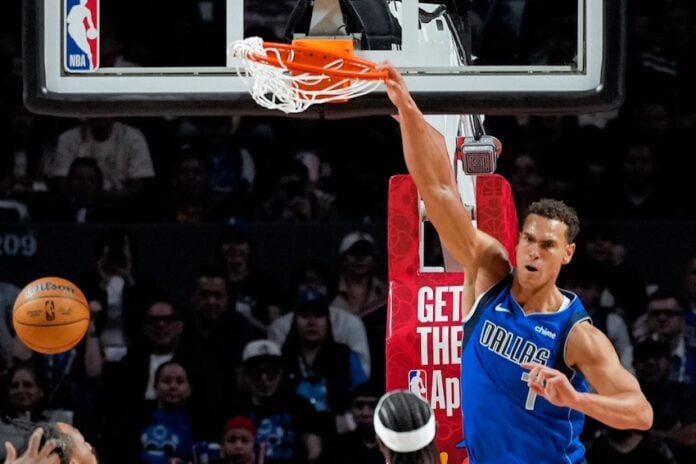The NBA arena’s hardwood floor featured a Día de Muertos skull. Mariachi music blasted from the auditorium speakers and multiple Dr. Simi mascots wearing NBA jerseys danced among fans in the crowd.
That was the scene this past Saturday when the Detroit Pistons clashed against the Dallas Mavericks at the Arena CDMX for the NBA’s annual friendly in Mexico City. The game — which featured alley-oop dunks and long-distance three-pointers — ended with the Pistons defeating the Mavs, 122-110, but less memorable than the score was the spectacle of it all.
The festive energy of the NBA’s annual Mexico City game was palpable, with a sellout crowd on a weekend that played host both to the Day of the Dead and Halloween. The NBA’s yearly excursion into the Aztec center is very much a circus — its main act being not only the high-flying athletes themselves, but the actual experience of being in the building and being seen, as it were, at the popular sporting event.
There is a capitalism to it all, of course: Michelob Ultra booths (an official sponsor of the NBA); a photo op with the Emirates-endorsed NBA Cup; official New Era apparel sold especially for this one-night-only event; a WNBA Día de Muertos altar, replete with custom papel picado that spells out the names of the WNBA’s biggest stars. Even the 2026 World Cup mascots were in the building, alongside Mexican celebrities, social media influencers and former NBA players, who each added their own spice to the eclectic swirl.
Admittedly, for someone who grew up in the United States with access to such events, it isn’t particularly life-changing to get your hands on an official NBA jersey. But this game isn’t for sports fans like me. It’s for the Mexican fans who, in many cases, may only be able to attend one NBA game in their lifetime — and this was that game.
And so the level of excitement and joy, among the majority of fans was evident, as many game-goers wore whatever NBA merchandise they already owned, even if those items had no correspondence to the teams or game on the court that evening. That didn’t matter. The annual NBA Mexico Game is about passion, not specifics; it’s for those who perhaps worked an entire week or month or more for this, and, as one local fan told me, made the sacrifices needed in order to have this night of enjoyment.
The NBA delivered on their end of the bargain in terms of entertainment value. In person, the event was all about everything happening outside of the game itself: neon-lit alebrije puppets galloping around, oversized calaca heads glowing in the dark, cempasúchil headwear on performers or catching an “NBA Mexico City 2025” shirt being tossed into the stands — and looking over at your friend to confirm that you did, indeed, catch the shirt. During intermissions, videos played of American players without much knowledge of Latin America raving about street tacos and attempting to speak Spanish.
Roaming the hallways of Arena CDMX was an electric experience, and, for the majority of Mexican fans, a foreign one. It may have seemed gimmicky to someone like me, but the overwhelming number of activities — kids shooting hoops, photo booths, fan centers for each team, just to name a few — was impressive. And the arena was loud. Everyone was engaged. You could feel the “Oh my God, I’m at my first NBA game” exhilaration among children and adults alike.

Even as an NBA fan, I’ll be the first to admit that the league — like any globally profitable product — is a corporate entity. But I am also here to tell you that sports are one of the very few things I’ve found around the world that can bring people together, if only for a moment, despite language barriers or any demographic differences.
So I say, the more the merrier. Keep the NBA coming back to Mexico. Hell, I’d love to see a full-blown franchise here (Canada has had two, so why not its neighbor to the south?). The NBA’s steady growth in Mexico has been obvious in the past five years alone, starting with the NBA’s acquisition of the Capitanes de Ciudad de Mexico at the end of 2019, who played their first official season in the NBA G League in 2021. NBA Commissioner Adam Silver has also constantly brought up Mexico City as a potential destination for a future expansion franchise (along with the more likely Las Vegas and Seattle).
But for now, we have this annual event. It’s fun. It’s different. And it’s imperfect — the internet wasn’t working very well in press row, much to the chagrin of many reporters and photographers behind me, and early in the game, the shot clock stopped functioning, something that I’ve never seen happen inside a U.S. venue. (The clocks were fixed at halftime by a scrambling on-court crew of workers while Mexican dancers performed to deafening music. Mexican surrealism at its finest.)
But in all, it was a Mexican experience disguised as an American sports outing. And in political times like these, I’ll take that as some kind of a win.
Alan Chazaro is the author of “This Is Not a Frank Ocean Cover Album,” “Piñata Theory” and “Notes From the Eastern Span of the Bay Bridge” (Ghost City Press, 2021). He is a graduate of June Jordan’s Poetry for the People program at UC Berkeley and a former Lawrence Ferlinghetti Fellow at the University of San Francisco. His writing can be found in GQ, NPR, The Guardian, L.A. Times and more. Originally from the San Francisco Bay Area, he is currently based in Veracruz.
